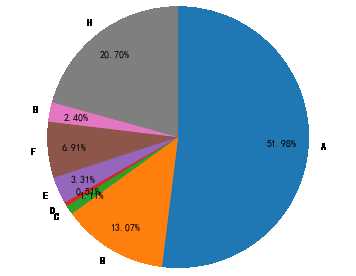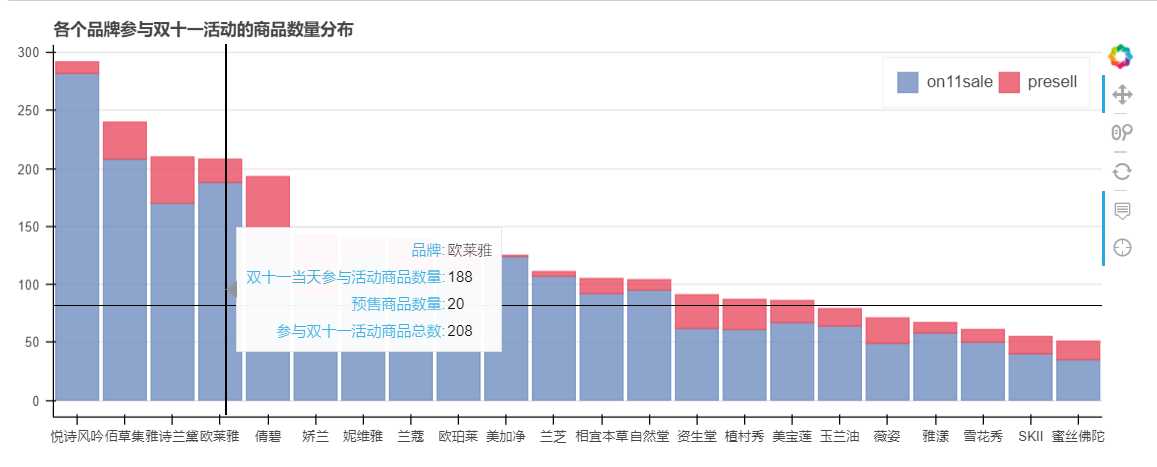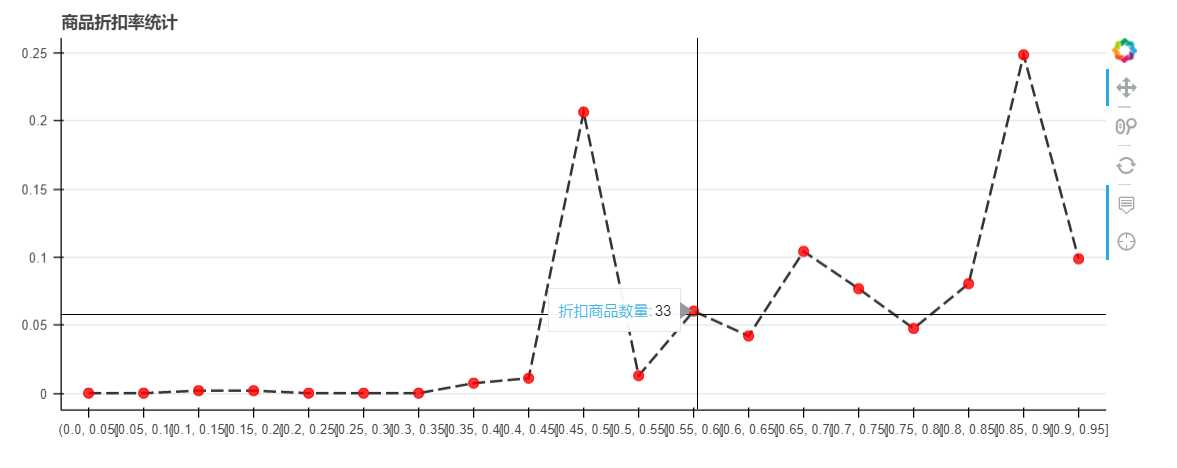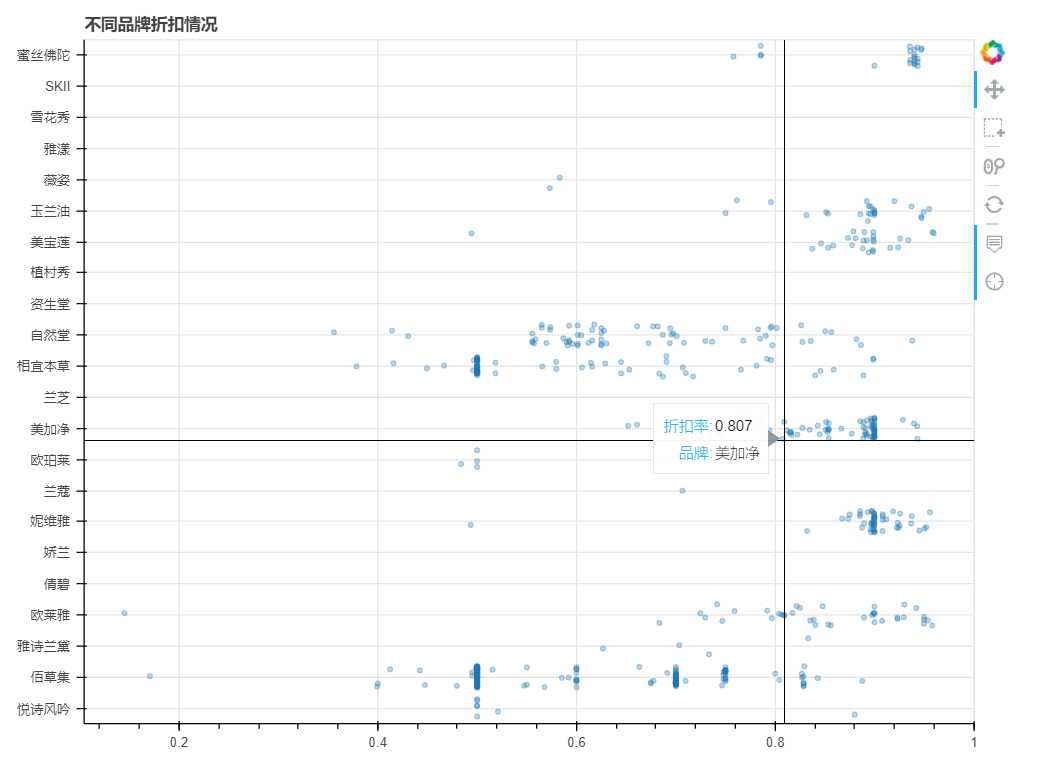标签:dbr png tips 大于 cell ossh 去除 汇总表 roman
——2016天猫双十一美妆数据分析
主要使用了Python中的Pandas库进行数据处理,利用matplotlib绘制分析图表,利用bokeh进行了可视化展示。
当前使用版本:Python 3.6.5 |Anaconda, Inc.| (default, Mar 29 2018, 13:32:41) [MSC v.1900 64 bit (AMD64)]
import numpy as np import pandas as pd import matplotlib.pyplot as plt % matplotlib inline import seaborn as sns import warnings warnings.filterwarnings(‘ignore‘) # 不发出警告 from bokeh.io import output_notebook output_notebook() # 导入notebook绘图模块 from bokeh.plotting import figure,show from bokeh.models import ColumnDataSource # 导入图表绘制、图标展示模块 # 导入ColumnDataSource模块 import os
# 加载数据 data = pd.read_excel(‘双十一淘宝美妆数据.xlsx‘) data[data.isnull().values == True].drop_duplicates # 检查缺失值 data.dtypes # 查看数据类型 data.index = data[‘update_time‘] data[‘date‘] = data.index.day # Series没有.day方法,利用index做了一步转换 data = data.drop(‘update_time‘, axis = 1) data.reset_index(inplace = True) data.rename(columns = {‘店名‘: ‘brand‘}, inplace = True) data.head()

统计商品总数和品牌总数:
data1 = data[[‘id‘,‘title‘, ‘brand‘, ‘price‘, ‘date‘]] items_num = len(data1[‘id‘].unique()) brands_num = len(data1[‘brand‘].unique()) print(‘商品总数为: %d‘ %items_num) print(‘品牌总数为: %d‘ %brands_num)
得到商品总数:3502,品牌总数:22
计算双十一当天在售商品占比:
items_at11 = data1[data1[‘date‘] == 11].drop_duplicates() items_at11_num = len(items_at11) precentage_11 = items_at11_num / items_num print(‘双十一当天在售商品占比为: %.2f%%‘ %(precentage_11 * 100))
得到双十一当天在售商品占比为:66.68%,约1/3的商品在双十一当天没有上架
为了分析没参加双十一的产品去向,我们首先对所有商品id依据其上架时间进行分类。
根据date字段,统计每件商品的最早和最迟销售时间;再统计双11当天是否销售;最后进行分类。
# 分析商品最早/最迟销售时间,及双11当天销售情况 data_sellrange = data1.groupby(‘id‘)[‘date‘].agg([‘min‘, ‘max‘]) id_at11 = data1[data1[‘date‘] == 11][‘id‘] data_temp1 = pd.DataFrame({‘id‘: id_at11, ‘on11sale‘: True}) data1_id = pd.merge(data_sellrange, data_temp1, left_index = True, right_on = ‘id‘, how = ‘left‘) data1_id.fillna(False, inplace = True) data1_id[‘type‘] = ‘unclassified‘ data1_id = data1_id.reset_index() data1_id = data1_id.drop(‘index‘, 1) data1_id.head() # 分类 data1_id = data1_id.reset_index() data1_id = data1_id.drop(‘index‘, 1) data1_id[‘type‘][(data1_id[‘min‘] < 11) & (data1_id[‘max‘] > 11)] = ‘A‘ data1_id[‘type‘][(data1_id[‘min‘] < 11) & (data1_id[‘max‘] == 11)] = ‘B‘ data1_id[‘type‘][(data1_id[‘min‘] == 11) & (data1_id[‘max‘] > 11)] = ‘C‘ data1_id[‘type‘][(data1_id[‘min‘] == 11) & (data1_id[‘max‘] == 11)] = ‘D‘ data1_id[‘type‘][data1_id[‘on11sale‘] == False] = ‘F‘ # 此时的F还包括E/H的情况 data1_id[‘type‘][data1_id[‘max‘] < 10] = ‘E‘ data1_id[‘type‘][data1_id[‘min‘] > 11] = ‘G‘ data1_id[‘type‘][data1_id[‘max‘] == 10] = ‘H‘ data1_id[data1_id[‘type‘] == ‘unclassified‘] # 检查分类是否完备 # 分类的可视化 result1 = data1_id[‘type‘].value_counts() # 用于可视化的数据命名为result result1 = result1.loc[[‘A‘, ‘B‘, ‘C‘, ‘D‘, ‘E‘, ‘F‘, ‘G‘, ‘H‘]] # 用于调整Series中Index的顺序 plt.rcParams[‘font.sans-serif‘]=[‘SimHei‘] # 用来正常显示中文标签 plt.axis(‘equal‘) # 保证长宽相等 --> 饼图为圆形 plt.pie(result1,labels = result1.index, autopct=‘%.2f%%‘,pctdistance=0.8,labeldistance =1.1, startangle=90, radius=1.5,counterclock=False) # 绘制饼图

# 选择数据字段 id_not11 = data1_id[data1_id[‘on11sale‘] == False] df_not11 = id_not11[[‘id‘, ‘type‘]] # 此时没有title字段,需要找到data1合并 data1_not11 = pd.merge(df_not11, data1, how = ‘left‘, on = ‘id‘) data1_not11.head() # case1 暂时下架 not11_case1 = data1_not11[data1_not11[‘type‘] == ‘F‘][‘id‘].drop_duplicates() id_case1 = not11_case1.reset_index().drop(‘index‘, 1) id_case1[‘case1‘] = 1 # .unique()出现numpy数组,drop_duplicates()返回Series # case2 更名上架 not11_case2 = data1_not11.groupby([‘id‘, ‘title‘]).count().reset_index() # 此时聚合的结果为每一个(id - title)对,对应的出现次数,即出现的日期和 title_count = not11_case2[‘id‘].value_counts().reset_index() # 计算id出现的次数,如果次数大于1,则说明商品更改过title # reset_index() 使原来index里的信息成为一个新的列 id_case2 = title_count[title_count[‘id‘] > 1][[‘index‘]] id_case2.columns = [‘id‘] id_case2[‘case2‘] = 1 # case3 预售 not11_case3 = data1_not11[data1_not11[‘title‘].str.contains(‘预售‘)] id_case3 = not11_case3[‘id‘].drop_duplicates().reset_index().drop(‘index‘, 1) # .unique() 返回ndarray / .drop_duplicates() 返回Serise id_case3[‘case3‘] = 1 # case4 未参与活动 not11_case4 = data1_not11[(data1_not11[‘type‘] == ‘E‘) | (data1_not11[‘type‘] == ‘G‘)][‘id‘].drop_duplicates() id_case4 = not11_case4.reset_index().drop(‘index‘, 1) id_case4[‘case4‘] = 1 print("未参与双十一当天活动的商品中:\n暂时下架商品的数量为%i个,更名上架商品的数量为%i个,预售商品的数量为%i个,未参与活动商品数量为%i个" %(len(id_case1), len(id_case2), len(id_case3), len(id_case4)))
未参与双十一当天活动的商品中:
暂时下架商品的数量为242个,更名上架商品的数量为110个,预售商品数量为453个,未参与活动商品数量为200个
# 查看没被分类的其他情况 id_not11_left = id_not11[[‘id‘, ‘min‘, ‘max‘, ‘type‘]].reset_index() id_not11_left = id_not11_left.drop(‘index‘, axis = 1) #id_not11_left[‘case‘] = ‘‘ id_not11_left = pd.merge(id_not11_left, id_case1, how = ‘left‘, on = ‘id‘) id_not11_left = pd.merge(id_not11_left, id_case2, how = ‘left‘, on = ‘id‘) id_not11_left = pd.merge(id_not11_left, id_case3, how = ‘left‘, on = ‘id‘) id_not11_left = pd.merge(id_not11_left, id_case4, how = ‘left‘, on = ‘id‘) id_not11_left = id_not11_left.fillna(0) id_not11_left[‘left‘] = id_not11_left[‘case1‘] + id_not11_left[‘case2‘] + id_not11_left[‘case3‘] + id_not11_left[‘case4‘] id_not11_others = id_not11_left[id_not11_left[‘left‘] == 0][[‘id‘, ‘min‘, ‘max‘, ‘type‘]] id_not11_others.head() # 未纳入分类的商品都是10日下架的,可能于双11当天售罄 # 暂时下架/更名上架/预售 可能互相包含
id_at11 = id_at11.reset_index().drop(‘index‘, 1) id_presell = id_case3[[‘id‘]] id_11all = pd.concat([id_at11, id_presell], ignore_index = True) # 筛选双十一当日在售商品和预售商品id id_presell[‘presell‘] = True id_11all[‘11all‘] = True data1_id = pd.merge(data1_id, id_presell, how = ‘left‘, on = ‘id‘) data1_id.fillna(False, inplace = True) data1_id = pd.merge(data1_id, id_11all, how = ‘left‘, on = ‘id‘) data1_id.fillna(False, inplace = True) data1_brand = data1[[‘id‘, ‘brand‘]].drop_duplicates() data1_id = pd.merge(data1_id, data1_brand, on = ‘id‘, how = ‘left‘) # 合并数据 销售情况 id brand data1_id.head() data1_on11sale = data1_id[data1_id[‘on11sale‘] == True] brand_on11sale = data1_on11sale.groupby(‘brand‘)[‘id‘].count() data1_presell = data1_id[data1_id[‘presell‘] == True] brand_presell = data1_presell.groupby(‘brand‘)[‘id‘].count() # 统计各品牌双十一当天在售和预售商品数量 # 利用bokeh绘制堆叠图 from bokeh.models import HoverTool from bokeh.core.properties import value result2 = pd.DataFrame({‘on11sale‘: brand_on11sale, ‘presell‘: brand_presell}) result2[‘11all‘] = result2[‘on11sale‘] + result2[‘presell‘] result2.sort_values(by = ‘11all‘, inplace = True, ascending = False) lst_brand = result2.index.tolist() lst_type = result2.columns.tolist()[:2] colors = ["#718dbf" ,"#e84d60"] # 设置好参数 result2.index.name = ‘brand‘ # 重命名标签 source1 = ColumnDataSource(result2) # 创建数据 hover1 = HoverTool(tooltips = [(‘品牌‘, ‘@brand‘), (‘双十一当天参与活动商品数量‘, ‘@on11sale‘), (‘预售商品数量‘, ‘@presell‘), (‘参与双十一活动商品总数‘, ‘@11all‘) ]) # 设置标签显示内容 #output_file(‘折扣商品数量.html‘) p1 = figure(x_range = lst_brand, plot_width = 900, plot_height = 350, title = ‘各个品牌参与双十一活动的商品数量分布‘, tools = [hover1, ‘reset, xwheel_zoom, pan, crosshair‘]) # 构建绘图空间 p1.vbar_stack(stackers = lst_type, x = ‘brand‘, source = source1, width = 0.9, color = colors, alpha = 0.8, legend = [value(x) for x in lst_type], muted_color = ‘black‘, muted_alpha = 0.2) # 绘制堆叠图 p1.xgrid.grid_line_color = None p1.axis.minor_tick_line_color = None p1.outline_line_color = None p1.legend.location = "top_right" p1.legend.orientation = "horizontal" p1.legend.click_policy="mute" # 设置其他参数 show(p1)

data1_brands = result2.copy() brand_total_item = data1_brand.groupby(‘brand‘).count() brand_total_item.columns = [‘total_items‘] data1_brands = pd.merge(data1_brands, brand_total_item, left_index = True, right_index = True, how = ‘outer‘) data1_brands.head()
| on11sale | presell | 11all | total_items | |
|---|---|---|---|---|
| brand | ||||
| SKII | 40 | 15 | 55 | 62 |
| 佰草集 | 208 | 32 | 240 | 279 |
| 倩碧 | 144 | 49 | 193 | 211 |
| 兰芝 | 107 | 4 | 111 | 156 |
| 兰蔻 | 112 | 27 | 139 | 168 |
1. 针对每个商品,分析其价格变化,判断是否打折
2. 针对在打折商品,计算其折扣率
3. 按照品牌分析,不同品牌的打折力度
4. 分析商家打折套路
data2 = data[[‘id‘, ‘title‘, ‘brand‘, ‘price‘, ‘date‘]] data2[‘period‘] = pd.cut(data2[‘date‘], [4, 10, 11, 14], labels = [‘双十一前‘, ‘双十一当天‘, ‘双十一后‘]) # 筛选数据 data2_price = data2[[‘id‘, ‘price‘, ‘period‘]].groupby([‘id‘, ‘period‘]).agg([‘min‘, ‘max‘]) data2_price.reset_index(inplace = True) data2_price.columns = [‘id‘, ‘period‘, ‘min_price‘, ‘max_price‘] # 找到每个时段对应的最高和最低价格 data2_price_before11 = data2_price[data2_price[‘period‘] == ‘双十一前‘] # 分析双十一之前的价格变化 --> 分析属于提前降价还是假打折(先涨价后降价) data2_price_before11_diff = data2_price_before11[data2_price_before11[‘min_price‘] != data2_price_before11[‘max_price‘]].reset_index().drop(‘index‘, 1) # 找出双十一前价格变化的商品 diff_id = data2_price_before11_diff[‘id‘].tolist() data2_diffprice = pd.merge(data2, data2_price_before11_diff, on = ‘id‘, how = ‘left‘) # 与原始数据合并,查看价格变化商品的具体情况 data2_diffpriceonly = data2_diffprice.dropna() data2_diffpriceonly.drop(‘period_y‘, 1, inplace = True) # 删除多余的列和缺失值 before11_diff = data2_diffpriceonly[data2_diffpriceonly[‘period_x‘] != ‘双十一后‘].reset_index().drop(‘index‘, 1) # 只查看双十一之前和当天的数据 before_11diffprice = before11_diff.pivot_table(index = ‘id‘, columns = ‘date‘, aggfunc = {‘price‘:min}) # 数据透视表 before_11diffprice.columns = [5, 6, 7, 8, 9, 10, 11] # 列名改用数字,不用字符串,方便运算 def function(df, *colnums): a = 0 for colnum in colnums: if df[colnum + 1] - df[colnum] > 0.1: a = 1 return a before_11diffprice[‘jdz‘] = before_11diffprice.apply(lambda x: function(x, 5, 6, 7, 8, 9), axis = 1) # 选择出涨价的商品在假打折列名标注1 # 只统计涨价1毛以上的 # DataFrame.apply函数的应用,如果设置axis参数为1则每次函数每次会取出DataFrame的一行来做处理 jdz_num = before_11diffprice[‘jdz‘].sum() # 共有16件商品假打折 jdz_items = pd.merge(data1_id, before_11diffprice, on = ‘id‘, how = ‘right‘) jdz_items = jdz_items[jdz_items[‘jdz‘] == 1] jdz_items = jdz_items[jdz_items[‘jdz‘] == 1].reset_index().drop(‘index‘, 1) jdz_id = jdz_items[[‘id‘, ‘jdz‘]] # 提取假打折商品id jdz_items

观察数据可知
data2_nocheat = pd.merge(data2, jdz_id, on = ‘id‘, how = ‘left‘) data2_nocheat[‘jdz‘].fillna(0, inplace = True) data2_nocheat = data2_nocheat[data2_nocheat.jdz.isin([0])] # 根据列条件删除行使用.isin(),参数为列表,如选择不包含,前面加负号 # 提取非假打折商品 price = data2_nocheat[[‘id‘, ‘price‘, ‘period‘]].groupby([‘id‘, ‘price‘]).min() price.reset_index(inplace = True) # 针对每个商品做price字段的value值统计,查看价格是否有波动 id_count = price[‘id‘].value_counts() id_type1 = id_count[id_count == 1].index # 价格无波动,不打折 id_type2 = id_count[id_count != 1].index # 价格变动 n1 = len(id_type1) n2 = len(id_type2) print(‘真打折的商品数量约占比%.2f%%,不打折的商品数量约占比%.2f%%, 假打折的商品数量约占比%.2f%%‘ % (n2/items_num * 100, n1/items_num * 100, jdz_num/items_num * 100)) # 计算打折商品比例
真打折的商品约占比24.27%,不打折的商品数量约占比75.27%,假打折的商品约占0.46%
result3_pivot = data2_nocheat.pivot_table(index = ‘id‘, columns = ‘period‘, aggfunc = {‘price‘: min}) # 数据透视可以一步到位,省却无数步骤 result3_pivot.columns = [‘price_before11‘, ‘price_on11‘, ‘price_after11‘] result3_pivot = result3_pivot.reset_index() nocheat_idbrand = data2_nocheat[[‘id‘, ‘brand‘]].drop_duplicates() result3_final = pd.merge(result3_pivot, nocheat_idbrand, on = ‘id‘).reset_index().drop(‘index‘, 1) # 与品牌名合并 result3_final[‘qzkl‘] = result3_final[‘price_on11‘] / result3_final[‘price_before11‘] result3_final[‘hzkl‘] = result3_final[‘price_on11‘] / result3_final[‘price_after11‘] # 计算商品的前后折扣率 result3_on11 = result3_final.dropna() # 筛选出双十一销售商品的折扣率 result3_zk = result3_on11[result3_on11[‘qzkl‘] < 0.96].reset_index() # 筛选出真打折的商品 result3_zk.head()
| index | id | price_before11 | price_on11 | price_after11 | brand | qzkl | hzkl | |
|---|---|---|---|---|---|---|---|---|
| 0 | 0 | A10027317366 | 188.0 | 159.00 | 258.0 | 相宜本草 | 0.845745 | 0.616279 |
| 1 | 2 | A10847151685 | 180.0 | 125.99 | 240.0 | 佰草集 | 0.699944 | 0.524958 |
| 2 | 8 | A12455538031 | 79.0 | 69.00 | 79.0 | 美宝莲 | 0.873418 | 0.873418 |
| 3 | 26 | A12591129422 | 189.0 | 179.00 | 250.0 | 玉兰油 | 0.947090 | 0.716000 |
| 4 | 35 | A12620798148 | 238.0 | 219.00 | 260.0 | 玉兰油 | 0.920168 | 0.842308 |
## 用bokeh绘制折线图:x轴为折扣率,y轴为商品数量占比 ## 商品折扣率统计,每个折扣区间与总打折商品占比 bokeh_data = result3_zk[[‘id‘, ‘qzkl‘]] bokeh_data[‘zkl_range‘] = pd.cut(bokeh_data[‘qzkl‘], bins = np.linspace(0, 1, 21)) # 创建折扣率区间 bokeh_data2 = bokeh_data.groupby(‘zkl_range‘).count().iloc[:-1] bokeh_data2[‘zkl_pre‘] = bokeh_data2[‘qzkl‘] / bokeh_data2[‘qzkl‘].sum() # 将数据按照折扣率拆分为不同区间,并统计不同1扣率的商品数量 bokeh_data2 = bokeh_data2.reset_index().drop(‘id‘, axis = 1) bokeh_data2.dtypes # 查看bokeh_data2数据类型,zkl_range类型为category --> str bokeh_data2[‘zkl_range‘] = bokeh_data2[‘zkl_range‘].astype(str) # bokeh_data2[‘zkl_range‘] = list(map(str,bokeh_data2[‘zkl_range‘])) bokeh_data2.head() #output_file(‘商品折扣率统计折线图.html‘) source2 = ColumnDataSource(bokeh_data2) lst_zkl = bokeh_data2[‘zkl_range‘].tolist() # 此时列表中每个元素均为str hover2 = HoverTool(tooltips = [(‘折扣商品数量‘, ‘@qzkl‘)]) p2 = figure(x_range = lst_zkl, plot_width = 900, plot_height = 350, title = ‘商品折扣率统计‘, tools = [hover2, ‘reset, xwheel_zoom, pan, crosshair‘]) # 构建绘图空间 p2.line(x = ‘zkl_range‘, y = ‘zkl_pre‘, source = source2, line_width = 2, line_alpha = 0.8, line_color = ‘black‘, line_dash = [10, 4]) p2.circle(x = ‘zkl_range‘, y = ‘zkl_pre‘, source = source2, size = 8, color = ‘red‘, alpha = 0.8) p2.xgrid.grid_line_color = None p2.axis.minor_tick_line_color = None p2.outline_line_color = None # 设置其他参数 show(p2)

观察上图可知,商品折扣率主要集中在五折和九折,二者共占50%以上
result3_zk[‘zk‘] = 1 # 根据id汇总数据 jdz_merge = jdz_items[[‘id‘, ‘jdz‘]] result3_zk_merge = result3_zk[[‘id‘, ‘zk‘]] data2_id = pd.merge(result3_final, jdz_merge, on = ‘id‘, how = ‘outer‘) data2_id[‘jdz‘].fillna(0, inplace = True) data2_id = pd.merge(data2_id, result3_zk_merge, on = ‘id‘, how = ‘outer‘) data2_id[‘zk‘].fillna(0, inplace = True) # 整理商品id的折扣情况 data1_id = data1_id.drop_duplicates() # 商品销售情况去重 data_id = pd.merge(data1_id, data2_id, on = ‘id‘, how = ‘outer‘) data_id.drop(‘brand_y‘, axis = 1, inplace = True) data_id.rename(columns = {‘min‘: ‘begin‘, ‘max‘: ‘end‘, ‘brand_x‘: ‘brand‘}, inplace = True) # 汇总商品id的全数据 data_id.head()

brand_zk_num = result3_zk.groupby(‘brand‘)[[‘id‘]].count() # 品牌折扣商品数 brand_jdz_num = jdz_items.groupby(‘brand‘)[[‘id‘]].count() # 品牌假打折商品数 brand_zk_num.columns = [‘zk_num‘] brand_jdz_num.columns = [‘jdz_num‘] #重命名 brand_zkmean = result3_zk.groupby(‘brand‘)[‘price_before11‘, ‘price_on11‘, ‘price_after11‘, ‘qzkl‘, ‘hzkl‘].mean() brand_zkmean.columns = [‘zkprice_before11‘, ‘zkprice_on11‘, ‘zkprice_after11‘, ‘qzkl_mean‘, ‘hzkl_mean‘] # 品牌折扣商品价格、折扣率均值 brand_totalmean = data_id.groupby(‘brand‘)[‘price_before11‘, ‘price_on11‘, ‘price_after11‘].mean() brand_totalmean.columns = [‘meanprice_before11‘, ‘meanprice_on11‘, ‘meanprice_after11‘] # 品牌商品价格均值 data2_brands = pd.merge(brand_zk_num, brand_jdz_num, left_index = True, right_index = True, how = ‘outer‘) data2_brands = pd.merge(data2_brands, brand_totalmean, left_index = True, right_index = True, how = ‘outer‘) data2_brands.fillna(0, inplace = True) data2_brands = pd.merge(data2_brands, brand_zkmean, left_index = True, right_index = True, how = ‘outer‘) # 汇总品牌价格折扣数据 data_brands = pd.merge(data1_brands, data2_brands, left_index = True, right_index = True, how = ‘outer‘) # 汇总品牌数据 data_brands[‘zk_pre‘] = data_brands[‘zk_num‘] / data_brands[‘total_items‘] # 计算品牌折扣商品比例 data_brands
from bokeh.transform import jitter brands = lst_brand.copy() # 提取品牌列表 bokeh_data3 = result3_final[[‘id‘, ‘qzkl‘, ‘brand‘]].dropna() bokeh_data3 = bokeh_data3[bokeh_data3[‘qzkl‘] < 0.96] source3 = ColumnDataSource(bokeh_data3) # 创建数据 #output_file(‘不同品牌折扣情况.html‘) hover3 = HoverTool(tooltips = [(‘折扣率‘, ‘@qzkl‘), (‘品牌‘, ‘@brand‘)]) # 设置标签显示内容 p3 = figure(y_range = brands, plot_width = 800, plot_height = 600, title = ‘不同品牌折扣情况‘, tools = [hover3, ‘box_select, reset, xwheel_zoom, pan, crosshair‘]) p3.circle(x = ‘qzkl‘, y = jitter(‘brand‘, width = 0.7, range = p3.y_range), source = source3, alpha = 0.3) # jitter参数 → ‘day‘:第一参数,这里指y的值 # width:间隔宽度比例,range:分类范围对象,这里和y轴的分类一致 show(p3)

bokeh_data4 = data_brands[[‘total_items‘, ‘qzkl_mean‘, ‘zk_pre‘]] bokeh_data4[‘size‘] = bokeh_data4[‘total_items‘] * 0.2 bokeh_data4.columns = [‘amount‘, ‘zkl‘, ‘pre‘, ‘size‘] bokeh_data4.reset_index(inplace = True) # 筛选出品牌商品总数,打折商品比例,平均折扣率 # 将点的大小设置为与商品总数有关 from bokeh.models.annotations import Span from bokeh.models.annotations import Label from bokeh.models.annotations import BoxAnnotation # 导入注释相关模块 source4 = ColumnDataSource(bokeh_data4) # 创建ColumnDataSource数据 #output_file(‘各个品牌打折套路解析.html‘) x_mean = bokeh_data4[‘pre‘].mean() y_mean = bokeh_data4[‘zkl‘].mean() hover4 = HoverTool(tooltips = [(‘品牌‘,‘@brand‘), (‘折扣率‘,‘@zkl‘), (‘商品总数‘,‘@amount‘), (‘参与打折商品比例‘,‘@pre‘)]) p4 = figure(plot_width = 800, plot_height = 800, title = ‘各个品牌打折套路解析‘, tools = [hover4,‘box_select,reset,wheel_zoom,pan,crosshair‘]) # 构建绘图空间 p4.circle_x(x = ‘pre‘, y = ‘zkl‘, source = source4, size = ‘size‘, fill_color = ‘red‘, line_color = ‘black‘, fill_alpha =0.6, line_dash = [8,3]) p4.ygrid.grid_line_dash = [6,4] p4.xgrid.grid_line_dash = [6,4] x = Span(location=x_mean, dimension=‘height‘, line_color=‘green‘,line_alpha = 0.7, line_width=1.5, line_dash = [6,4]) y = Span(location=y_mean, dimension=‘width‘, line_color=‘green‘,line_alpha = 0.7, line_width=1.5, line_dash = [6,4]) p4.add_layout(x) p4.add_layout(y) # 绘制辅助线 bg1 = BoxAnnotation(bottom=y_mean, right=x_mean,fill_alpha=0.1, fill_color=‘olive‘) label1 = Label(x=0.0, y=0.60,text="少量大打折",text_font_size="10pt" ) p4.add_layout(bg1) p4.add_layout(label1) # 绘制第一象限 bg2 = BoxAnnotation(bottom=y_mean, left=x_mean,fill_alpha=0.1, fill_color=‘firebrick‘) label2 = Label(x=0.35, y=0.60,text="大量大打折",text_font_size="10pt" ) p4.add_layout(bg2) p4.add_layout(label2) # 绘制第二象限 bg3 = BoxAnnotation(top=y_mean, right=x_mean,fill_alpha=0.1, fill_color=‘firebrick‘) label3 = Label(x=0.0, y=0.80,text="少量少打折",text_font_size="10pt" ) p4.add_layout(bg3) p4.add_layout(label3) # 绘制第三象限 bg4 = BoxAnnotation(top=y_mean, left=x_mean,fill_alpha=0.1, fill_color=‘olive‘) label4 = Label(x=0.35, y=0.80,text="大量少打折",text_font_size="10pt" ) p4.add_layout(bg4) p4.add_layout(label4) # 绘制第四象限 show(p4)

# 商品id资料表格 data_id_ch = data_id.copy() data_id_ch.columns = [‘最早上架‘, ‘最迟上架‘, ‘商品id‘, ‘双十一当天售卖‘, ‘销售时间分类‘, ‘是否预售‘, ‘预售+双11当天‘, ‘品牌‘, ‘双十一前价格‘, ‘双十一当天价格‘, ‘双十一之后价格‘, ‘前折扣率‘, ‘后折扣率‘, ‘假打折‘, ‘真打折‘] data_brands_ch = data_brands.copy() data_brands_ch.columns = [‘双十一当日商品数‘, ‘预售商品数‘, ‘双十一商品总数‘, ‘商品总数‘, ‘真打折商品数‘, ‘假打折商品数‘, ‘双十一前均价‘, ‘双十一当天均价‘, ‘双十一之后均价‘, ‘打折商品双十一前均价‘, ‘打折商品双十一均价‘, ‘打折商品双十一之后均价‘, ‘平均前折扣率‘, ‘平均后折扣率‘, ‘折扣商品占比‘] jdz_items_ch = jdz_items.copy() jdz_items_ch.columns = [‘最早上架‘, ‘最迟上架‘, ‘商品id‘, ‘双十一当天售卖‘, ‘销售时间分类‘, ‘是否预售‘, ‘预售+双11当天‘, ‘品牌‘, ‘5日价格‘, ‘6日价格‘, ‘7日价格‘, ‘8日价格‘, ‘9日价格‘, ‘10日价格‘, ‘11日价格‘, ‘假打折‘] data_id_ch.to_excel(‘商品id资料表格.xlsx‘) data_brands_ch.to_excel(‘品牌汇总资料表格.xlsx‘) jdz_items_ch.to_excel(‘假打折商品详情.xlsx‘) data_id.to_excel(‘data_id.xlsx‘) data_brands.to_excel(‘data_brands.xlsx‘) jdz_items.to_excel(‘jdz_items.xlsx‘)
标签:dbr png tips 大于 cell ossh 去除 汇总表 roman
原文地址:https://www.cnblogs.com/simon95/p/9898800.html